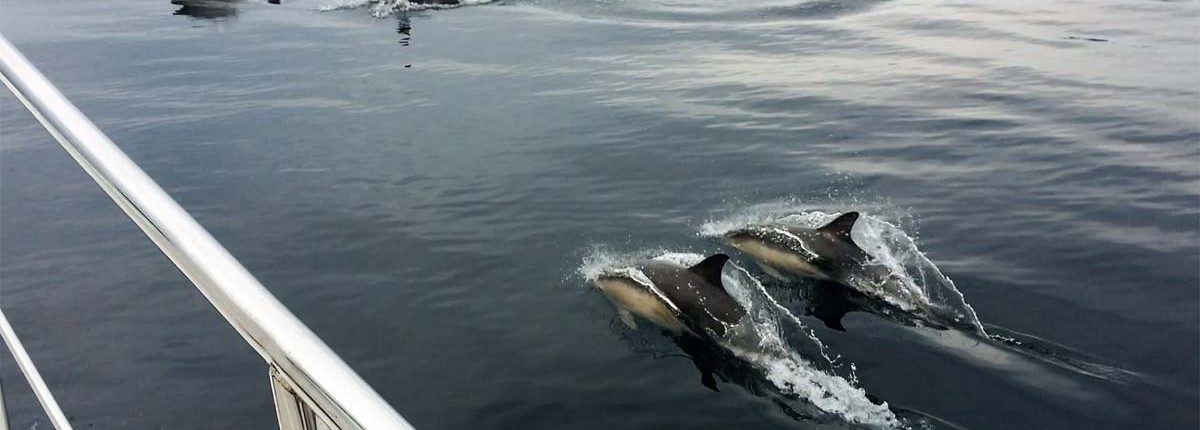Wildlife of the Northwest Highlands & Islands
The seas around the Northwest Highlands and Islands are alive with movement, colour, and sound. Our cruises frequently bring you closer to Scotland’s remarkable sea life than you ever imagined.
Seasonal Highlights
-
Spring & Summer Fish Runs
From spring onwards, mackerel, sand eels, and sprats gather in abundance, filling bays on warm summer evenings. Their arrival draws in larger predators — and some of the sea’s most spectacular visitors. -
Dolphins & Porpoises
-
Bottlenose Dolphins appear in April, playful and often seen around the Small Isles.
-
Common Dolphins arrive in May, delighting in racing and leaping alongside boats.
-
Harbour Porpoises remain year-round, shy but sometimes forming large pods further offshore.
-
-
Whales
-
Minke Whales are commonly sighted feeding around the Isle of Muck, drawn by tidal flows and rich feeding grounds.
-
Humpback Whales and Killer Whales (Orcas) are rare, but unforgettable when encountered.
-
-
Summer Giants
During hot summer months, Basking Sharks — gentle, harmless filter-feeders — cruise the waters. Their sheer size is awe-inspiring, despite their peaceful nature.
Other Marine Life
-
Jellyfish: From delicate moon jellyfish to compass jellyfish, massive “dustbin-lid” jellyfish, and the fiery lion’s mane jellyfish (the world’s third-longest animal).
-
Sunfish: Occasionally spotted, these odd, flat-bodied creatures add to the mystery of the seas.
Birdlife
-
The white-tailed sea eagle — reintroduced on Rum after going extinct in Scotland in the 1920s — is now a thrilling sight on our cruises.
-
Countless seabirds thrive here, each adding movement and sound to the dramatic coastal skies.
✨ From dolphins to eagles, jellyfish to whales, every trip brings a new encounter with Scotland’s wild and untamed nature.
Book one of our adventures for the chance to experience the local wildlife for yourself!
Coastal-life
As one might expect, the area’s coastal beaches and cliffs are home to a diverse range of wildlife. A look into any barnacle-encrusted rockpool on any shore should give you an impression of this variety; this is a look into a floating, transparent world of fluted shells and shards of coral, blue mussels, mermaids’ purses, violet-spined sea urchins, squashy and bright red sea anemones, green shore crabs and velvet swimming crabs, hermit crabs, winkles and dog whelks, armoured limpets, darting shrimp and the Great British blennies.
In these waters around our coastline we have made a habit of laying down creels to catch edible crabs and lobsters, which ordinarily would not scuttle too close to land. This variety of fish and shellfish is obviously why so many animals choose to cluster around the coastlines, such as families of otters and the common and grey seals that are regularly to be seen on the shores around Loch Nevis. Some seals, though, would seem to prefer for themselves an easier lifestyle and enjoy being hand-fed from the pontoon in the harbour!
The area’s coastlines also accommodate a great deal of bird life. Come late July and into August, these communities flourish around the islands and Loch Nevis, where you can see gannets diving on shoals of mackerel. Colonies of puffins can be found nesting on the grassy cliffs of Muck and Canna, Across the water, on Rum, there is, come July, the largest rafting of manx shearwaters to be found in the UK. Down on the shorelines you can find cormorants and shags perched on the rocks like question marks and, Eider ducks paddling in the tidal shallows.
Mountain/Loch-life
Drawing back from the sea and the shorelines, the hills and lochs still boast their own wildlife. The area is home to many iconic woodland and highland animals and birds, such as the red deer bounding across the hills. Walking alongside the Lochs and their estuaries you can sometimes spot otters scampering in and out of the water. Apart from the various species of waterfowl to be seen paddling and wading there, grey herons commonly make their nests along these waters. Weasels, stoats, and badgers like to keep out of sight, but sometimes pop up and you might get to spy Pine Martens clambering up trees to hide and shelter from the area’s several species of raptor, such as sparrowhawks, buzzards, kestrels, barn owls and, perhaps most magnificent of all, the golden eagle.
Rum’s national park has some things to see that are peculiar to that island alone. For example, on the slopes of Rum’s hillsides you can find wild goats leaping from stone to stone and a population of wild ponies that have been on the island for some one thousand years! Indeed, Rum’s famous population of red deer has been on the island so long that they are protected by law. The island’s woods, much like those of the mainland, murmur with small woodland birds, but the hill-lochs of the island play home to some rare varieties of waterfowl like red-throated divers; lochs, it might be added, whose peat stained waters abound with magnificent wild brown trout.
Book one of our adventures for the chance to experience the local wildlife for yourself!





